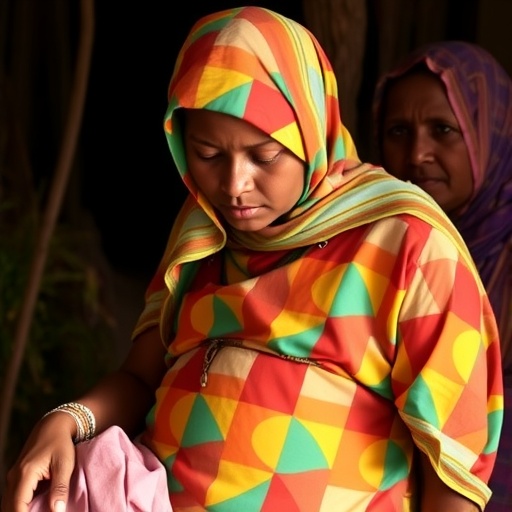In a groundbreaking new study published in “Global Health Research and Policy,” researchers Guo, Liu, and Wang have unveiled an intricate analysis of how expanding health intervention coverage could dramatically reduce maternal mortality across 126 low- and middle-income countries. Utilizing the Lives Saved Tool (LiST), a sophisticated modeling framework, the team quantified the potential life-saving impact of various maternal health interventions, offering unprecedented clarity on strategies to combat one of the world’s most persistent public health challenges.
Maternal mortality remains a critical issue globally, particularly in resource-constrained settings where access to quality healthcare services is uneven and often insufficient. Despite concerted international efforts to achieve the Sustainable Development Goals (SDGs), particularly SDG 3.1 which targets a reduction in the global maternal mortality ratio, progress has been uneven. This study confronts this challenge head-on by leveraging advanced modeling techniques to simulate the effects of improving intervention coverage, thereby illuminating pathways toward substantial mortality reductions.
The Lives Saved Tool integrates demographic, epidemiological, and intervention coverage data to estimate the impact of health programs on mortality. In this study, the researchers aggregated vast datasets encompassing 126 countries, capturing complex health system dynamics and maternal mortality patterns. This extensive scope allowed for nuanced stratification of results, revealing both global trends and country-specific insights, which are vital for tailoring effective health policies.
Crucially, the model examined a range of maternal health interventions spanning prenatal, perinatal, and postnatal periods. These included antenatal care visits, skilled birth attendance, emergency obstetric care, and postpartum family planning, among others. Each intervention’s coverage level was methodically adjusted within the model to project the corresponding reduction in maternal deaths, demonstrating a clear dose-response relationship between health service utilization and maternal survival.
One of the most compelling findings was the heterogeneity of intervention effectiveness across different countries and regions. Variations in baseline coverage, health system infrastructure, and socioeconomic factors mean that while some interventions yield substantial mortality reductions universally, others have context-dependent impacts. This insight underscores the importance of localized health policies that prioritize interventions according to regional maternal health landscapes.
The study’s projections reveal that achieving near-universal coverage of a core set of evidence-based interventions could avert a staggering proportion of maternal deaths. For example, ensuring that every woman receives comprehensive antenatal care and has access to skilled birth attendants could single-handedly reduce maternal mortality rates by up to 40% in many regions. When combined with high-quality emergency obstetric care, the potential mortality reduction surpasses 50%, signaling a transformative opportunity.
Beyond pure mortality metrics, the research also highlights broader health system benefits stemming from expanded intervention coverage. Enhanced maternal health services often serve as entry points for improving neonatal outcomes, family planning uptake, and women’s overall health status. Thus, the study advocates for integrated health strategies that amplify the ripple effects of targeted maternal health programs.
Methodologically, Guo and colleagues underscore the robustness of the Lives Saved Tool as both a predictive and planning instrument. By incorporating up-to-date epidemiological data and refined assumptions about intervention efficacy, the model provides policymakers with actionable projections that balance optimism with pragmatism. The transparent framework allows adjustments for future data inputs, ensuring adaptability amid evolving health landscapes.
However, the authors candidly acknowledge limitations inherent in modeling studies. Data quality variability across participating countries, potential underreporting of maternal deaths, and assumptions regarding intervention uptake and effectiveness introduce uncertainties. They advocate for continuous data strengthening initiatives and field validations to refine model precision and maintain relevance.
The study arrives at a crucial juncture when global health stakeholders are recalibrating maternal mortality reduction strategies in the aftermath of disruptions caused by the COVID-19 pandemic. Health systems worldwide face resource constraints and shifting priorities, making evidence-based modeling indispensable for identifying high-impact, cost-effective interventions. This research supplies a rigorously quantified roadmap that promises to guide resource allocation effectively.
Importantly, the findings raise a clarion call to international donors, national governments, and healthcare providers to intensify efforts on scaling up maternal health services. The intersection of political will, financial investment, and community engagement is emphasized as fundamental to translating model projections into tangible health improvements.
The researchers further delve into policy implications, arguing for integrated approaches that strengthen health system components such as workforce training, supply chains, and data systems. Without addressing these structural determinants, increased intervention coverage may falter in achieving its life-saving potential. The study invites candid discourse on sustainable health system investments as a critical underpinning of maternal mortality reduction.
At its core, this study exemplifies how cutting-edge modeling techniques can empower global health initiatives. By translating complex data into digestible, actionable insights, the research bridges the gap between epidemiological theory and public health practice. It establishes a new benchmark for maternal health intervention planning in low- and middle-income countries.
While the challenges in eradicating maternal mortality are formidable, the analytical clarity offered through this research fosters cautious optimism. Scaling up proven maternal health interventions aligned with local needs could transform maternal health outcomes significantly over the coming decade. The research boldly propels momentum toward realizing international commitments to safer motherhood.
In sum, this modeling study by Guo, Liu, and Wang represents a major contribution to global health literature. It quantifies the promise of health intervention coverage expansion with unprecedented specificity, informs strategic decision-making, and galvanizes a collective push to save mothers’ lives. The synthesis of data, methodology, and policy discourse offers a roadmap not just for survival but for thriving maternal health systems worldwide.
Subject of Research: The impact of health intervention coverage on reducing maternal mortality in low- and middle-income countries using Lives Saved Tool modeling.
Article Title: Impact of health intervention coverage on reducing maternal mortality in 126 low- and middle-income countries: a Lives Saved Tool modelling study.
Article References:
Guo, XR., Liu, J. & Wang, HJ. Impact of health intervention coverage on reducing maternal mortality in 126 low- and middle-income countries: a Lives Saved Tool modelling study. glob health res policy 10, 15 (2025). https://doi.org/10.1186/s41256-025-00414-0
Image Credits: AI Generated
DOI: https://doi.org/10.1186/s41256-025-00414-0




